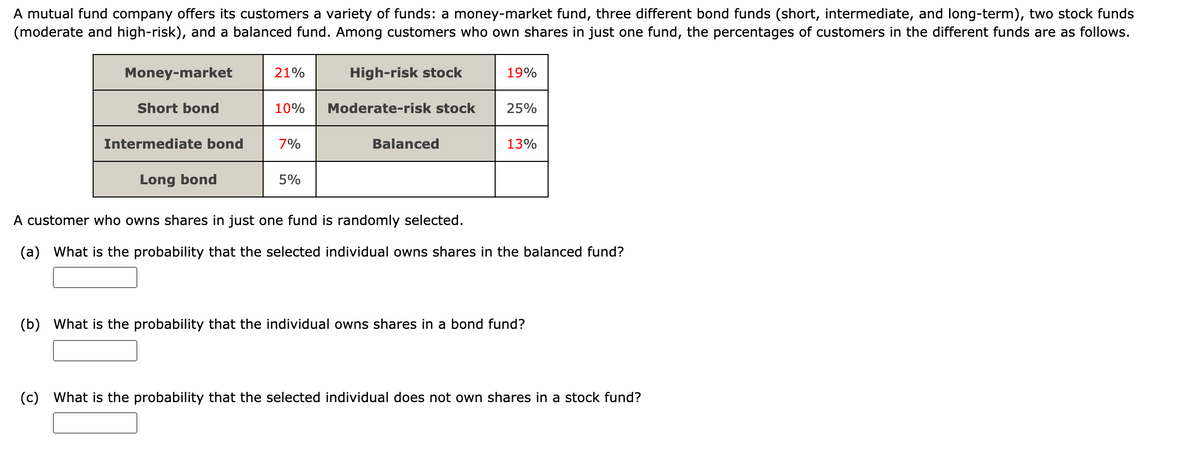A mutual fund company offers its customers a variety of funds: a money-market fund, three different bond funds (short, intermediate, and long-term), two stock funds (moderate and high-risk), and a balanced fund. Among customers who own shares in just one fund, the percentages of customers in the different funds are as follows. Money-market 21% High-risk stock 19% Short bond 10% Moderate-risk stock 25% Intermediate bond 7% Balanced 13% Long bond 5% A customer who owns shares in just one fund is randomly selected. (a) What is the probability that the selected individual owns shares in the balanced fund? (b) What is the probability that the individual owns shares in a bond fund? (c) What is the probability that the selected individual does not own shares in a stock fund?
A mutual fund company offers its customers a variety of funds: a money-market fund, three different bond funds (short, intermediate, and long-term), two stock funds (moderate and high-risk), and a balanced fund. Among customers who own shares in just one fund, the percentages of customers in the different funds are as follows. Money-market 21% High-risk stock 19% Short bond 10% Moderate-risk stock 25% Intermediate bond 7% Balanced 13% Long bond 5% A customer who owns shares in just one fund is randomly selected. (a) What is the probability that the selected individual owns shares in the balanced fund? (b) What is the probability that the individual owns shares in a bond fund? (c) What is the probability that the selected individual does not own shares in a stock fund?
A First Course in Probability (10th Edition)
10th Edition
ISBN:9780134753119
Author:Sheldon Ross
Publisher:Sheldon Ross
Chapter1: Combinatorial Analysis
Section: Chapter Questions
Problem 1.1P: a. How many different 7-place license plates are possible if the first 2 places are for letters and...
Related questions
Topic Video
Question

Transcribed Image Text:A mutual fund company offers its customers a variety of funds: a money-market fund, three different bond funds (short, intermediate, and long-term), two stock funds
(moderate and high-risk), and a balanced fund. Among customers who own shares in just one fund, the percentages of customers in the different funds are as follows.
Money-market
21%
High-risk stock
19%
Short bond
10%
Moderate-risk stock
25%
Intermediate bond
7%
Balanced
13%
Long bond
5%
A customer who owns shares in just one fund is randomly selected.
(a) What is the probability that the selected individual owns shares in the balanced fund?
(b) What is the probability that the individual owns shares in a bond fund?
(c) What is the probability that the selected individual does not own shares in a stock fund?
Expert Solution
This question has been solved!
Explore an expertly crafted, step-by-step solution for a thorough understanding of key concepts.
This is a popular solution!
Trending now
This is a popular solution!
Step by step
Solved in 2 steps

Knowledge Booster
Learn more about
Need a deep-dive on the concept behind this application? Look no further. Learn more about this topic, probability and related others by exploring similar questions and additional content below.Recommended textbooks for you

A First Course in Probability (10th Edition)
Probability
ISBN:
9780134753119
Author:
Sheldon Ross
Publisher:
PEARSON


A First Course in Probability (10th Edition)
Probability
ISBN:
9780134753119
Author:
Sheldon Ross
Publisher:
PEARSON
